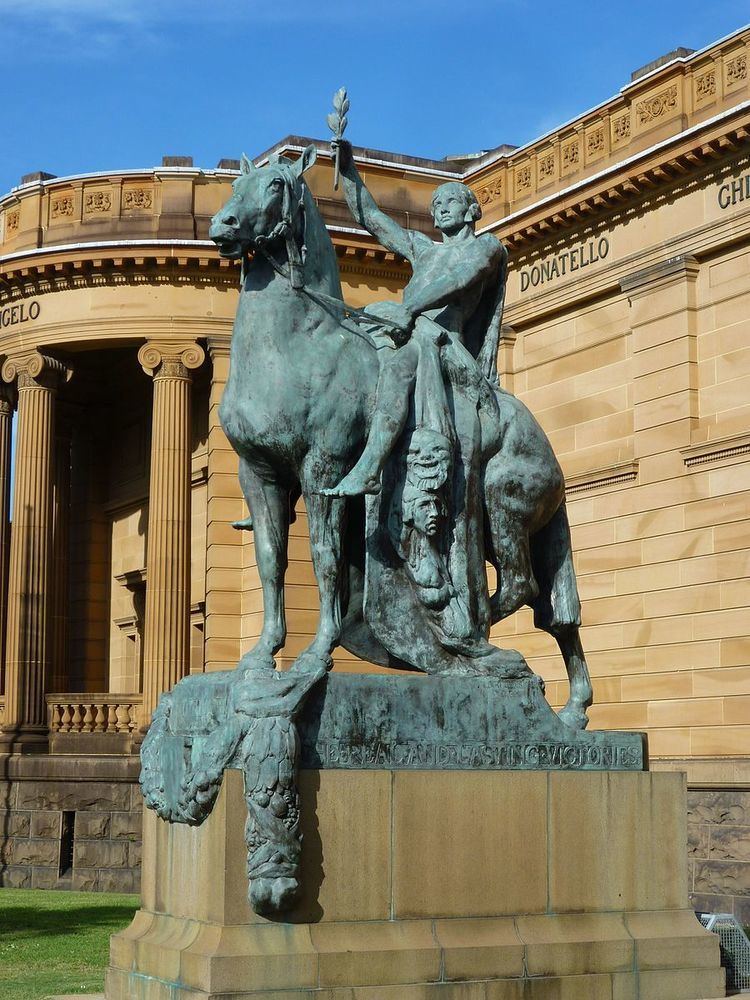 | ||
The Offerings of Peace and The Offerings of War are a pair of bronze allegorical equestrian statues by Gilbert Bayes commissioned for the entrance of the Art Gallery of New South Wales. They have been on permanent display since their installation in 1926.
Contents
Description
"Peace" (on the left of the Gallery entrance) and "War" (on the right) each show a male rider astride a horse. The models for the works are the Elgin Marbles and the riders carry symbolic items as their "offerings". Peace carries the Greek theatre masks of Tragedy and Comedy representing "the arts" and "plenty", while War holds a staff, a bundle of swords and broken spear shafts. Artistically, they "make no concession to the twentieth century" and are "...completely at one with the neo-classical Victorian facade [of the gallery], which is in itself allegorical."
Commission
In 1903 Bayes was commissioned to design a bronze relief panel for the façade of the New South Wales Art Gallery. "Subjects typical of Assyrian or Egyptian art were required." His design depicting Assur-Natsir-Pal, King of Assyria, was produced in 1906 and in 1907 became the first panel to be installed on the façade.
In 1915, after the outbreak of World War I, Bayes submitted to the National Art Gallery of New South Walesa "a pair of 18 inch bronzed plaster figures entitled Offerings of Peace and Offerings of War and the following year he received the commission to produce large bronze versions to flank the museum's main entrance.b
Work on War and Peace was interrupted by the war itself, from which Bayes was exempted because of this commission. Full size plaster statues were finally completed in 1919, cast in England in 1923, shipped separately to Sydney in 1924 (first War in February, then Peace in June) and erected in 1926. The statues were, according to their inscription, cast at the Thames Ditton foundry by A. B. Burton, considered by contemporaries to be "the finest bronze caster in the world". These would be the first of several Sydney commissions for Burton.c
Standing 14 feet high and weighing six tons, the works were originally commissioned for ₤1500 each; the eventual cost rose to ₤2300 each.
Installation
The expectation at the time of commissioning the sculptures was that they would be situated at an angle on either side of the portico at the top of the entrance steps. Purpose-built plinths had been included in the construction of the facade for the statues' eventual installation. However, once the statues had been delivered, the gallery trustees decided instead to install the works on free-standing plinths halfway down either side the length of the facade. In May 1926 a separate tender was called for the plinth construction and the installation of the sculptures, with the eventual installation taking place in October.
Conservation
By 1993 the sculptures needed conservation treatment as a result of damage from air and sea pollution - sulphur dioxide from car exhausts and chlorides from the sea. Funds were allocated from the Department of Public Works to address the problems. The Art Gallery's Conservator wrote that "Until we can solve our social problems, conservators will continue to search for better corrosion inhibitors, more durable waterproof coatings and innovative ways to prevent vandalism".
War and peace and in between
War and Peace and in between was a site-specific installation artwork by Tatzu Nishi in which the sculptures were incorporated into domestic scenes. The work was commissioned by Kaldor Public Art Projects and was on display from October 2009 to February 2010. The work coincided with a retrospective being held at the gallery at the time, in recognition of 40 years of Kaldor projects - the first having been also in Sydney - Christo's Wrapped Coast at Little Bay in 1969.
